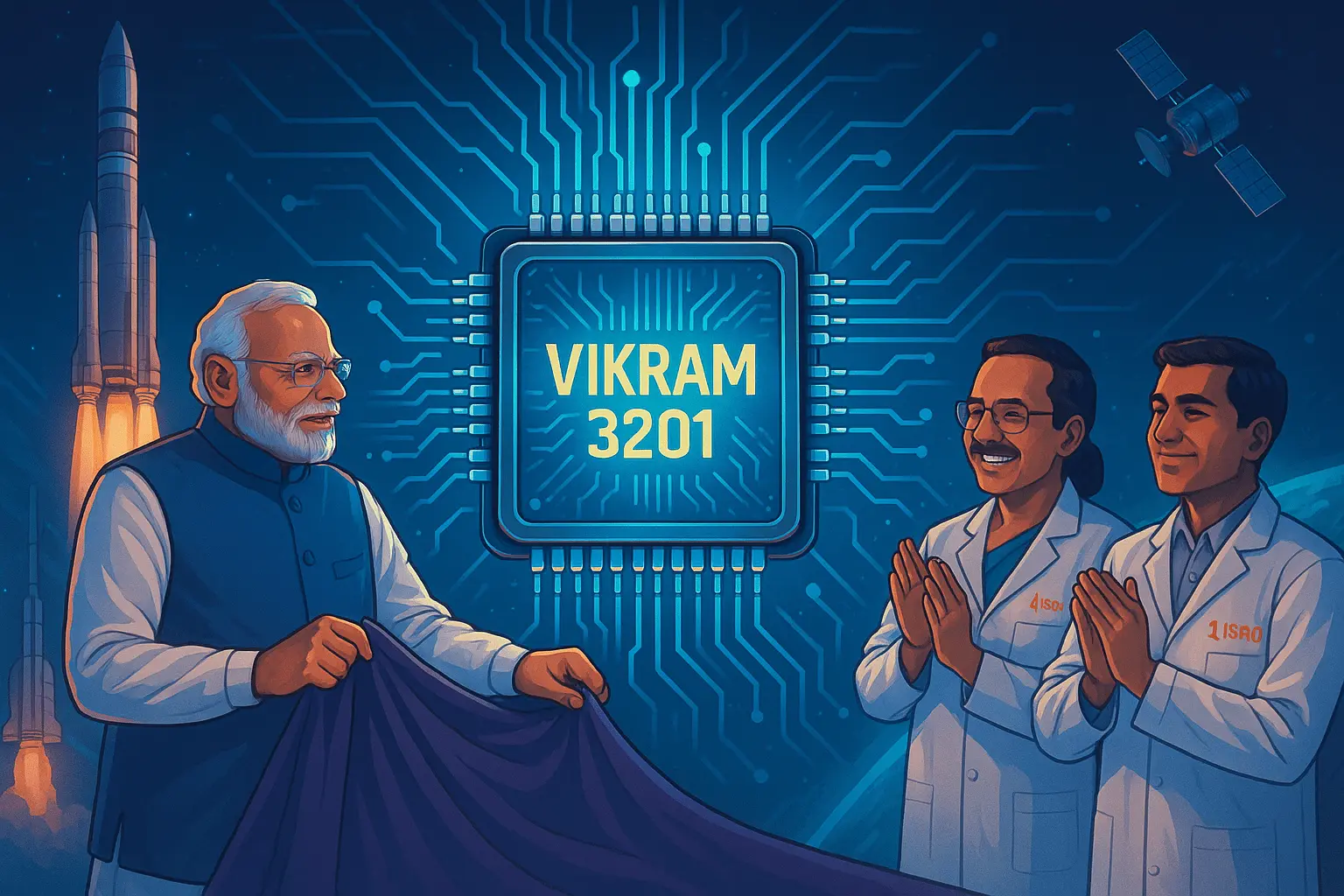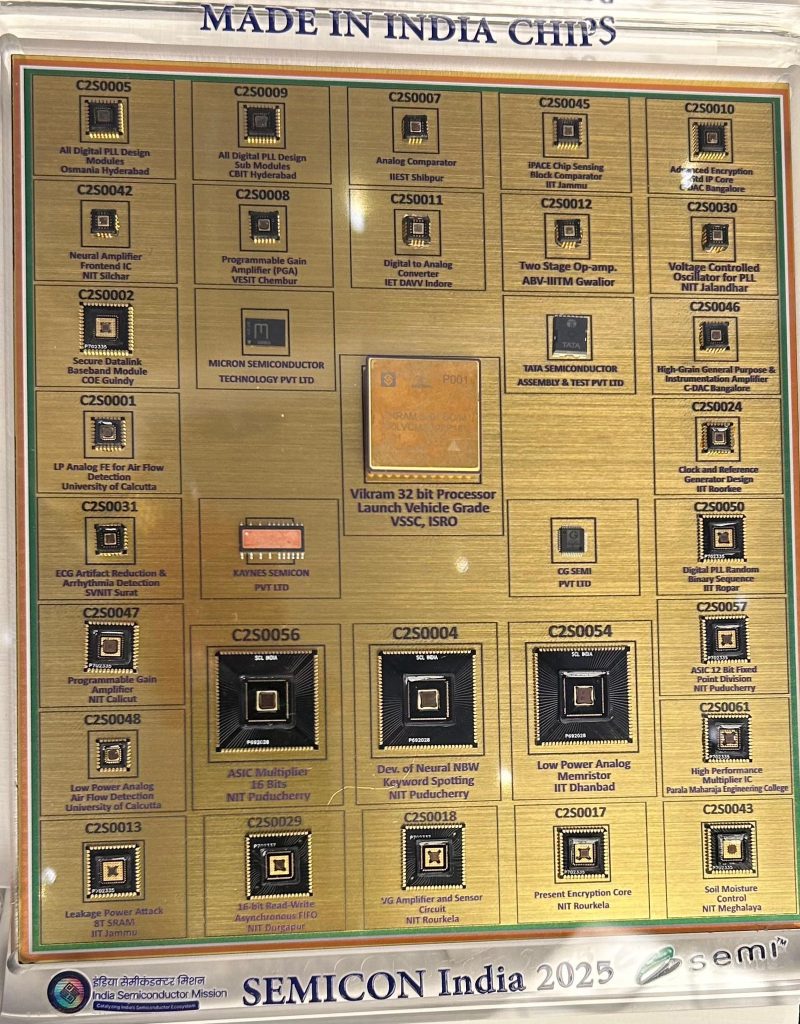Vikram 3201: India’s First Indigenous Microchip for Space & Defense

Chips are everywhere — from smartphones to satellites — and control the modern world. For decades, India relied on imports, but the tide has started to turn. At the Semicon India 2025 conference in Delhi, PM Modi unveiled Vikram 3201, India’s first fully indigenous high-performance microprocessor, designed by ISRO and fabricated in Chandigarh. This chip may not power your smartphone, but it is a game-changer for India’s space and defence sectors. More importantly, it marks the beginning of India’s long journey into semiconductor manufacturing.
Why Semiconductors Matter for India
Semiconductors are the “brain” inside every electronic device. Without them, there’s no smartphone, car, laptop, or satellite. India spends $25–30 billion annually importing chips. Relying on foreign suppliers is risky, especially during global shortages or geopolitical tensions. By producing its own chips, India reduces its dependence, saves billions, and enhances security in critical sectors such as defence, telecom, and energy.
The India Semiconductor Mission
Launched in 2021 with an investment of ₹76,000 crore, this mission rests on three pillars:
- Manufacturing ecosystem: Building fabs, assembly, and testing units in India.
- Design ecosystem: Supporting fabless chip startups to design chips in India instead of just for foreign clients.
- Research & talent: Training engineers, funding R&D labs, and creating specialised manpower.
The unveiling of Vikram 3201 marks one of the first significant successes under this mission.
Introducing Vikram 3201 Microprocessor
- Developed by ISRO’s Vikram Sarabhai Space Centre.
- Fabricated by the Semiconductor Laboratory (SCL), Chandigarh.
- Named after Dr. Vikram Sarabhai, the father of India’s space program.
- Certified for space launch conditions — can handle extreme heat, vibrations, and radiation.
- First fully indigenous high-performance chip designed, made, and tested in India.
This chip will be used in rockets and satellites, where reliability matters more than size.
Technical Highlights
- 32-bit architecture
- Supports floating-point arithmetic (vital for navigation & scientific computing)
- Compatible with Ada programming language (standard in aerospace & defence)
- C compiler under development for broader use
- Radiation-tolerant design for cosmic conditions
- Tested successfully in PSLV-C missions
- Resistant to shocks, vibration, and extreme temperatures
Note: Unlike consumer chips (3nm or 5nm), Vikram 3201 is made on 180nm technology — larger, but far more reliable for space.

Why This Chip Matters Strategically
- Self-Reliance: ISRO no longer depends on foreign space-grade chips.
- Boosts Confidence: Proves India can design, fabricate, and test chips end-to-end.
- Defence & Security: Can be used in missiles, satellites, and secure systems.
- Investor Signal: Shows India’s seriousness in semiconductors, attracting global partnerships.
India’s Roadmap for Semiconductors
- Fabs under construction in Gujarat, Assam, and Karnataka.
- OSAT (Outsourced Assembly & Testing) plants are being set up.
- 30+ startups funded under the Design Linked Incentive Scheme.
- Universities partnering for chip design labs and training.
- Future: Kalpana series (64-bit successor) already in development for advanced satellite use.
- Gradual scaling from 180nm → 65nm → smaller nodes, aiming to reach global competitiveness.
The Global Context
- USA: Strong in design (Intel, Qualcomm, Nvidia) but depends on Taiwan’s TSMC for manufacturing.
- China: Heavy subsidies, pushing towards 7nm despite sanctions, but still behind cutting-edge nodes.
- South Korea & Taiwan: Global leaders in advanced chip manufacturing.
- India: Just beginning, but with 20% of the global chip design workforce, it has a unique advantage.
The Vikram 3201 isn’t about competing with Apple or TSMC today — it’s about laying the foundation for tomorrow.
Conclusion
The launch of the Vikram 3201 microprocessor is more than a technological achievement — it’s a symbol of India’s determination to control its future in the semiconductor era. Yes, India still has miles to go before matching global leaders. But the first step has been taken: from importing every chip to making our own for space missions. For citizens, the message is clear — India’s journey into semiconductors has started, and the possibilities are vast. Today, Vikram 3201. Tomorrow, who knows — maybe the chip inside your next smartphone.









No comments yet. Be the first to comment!